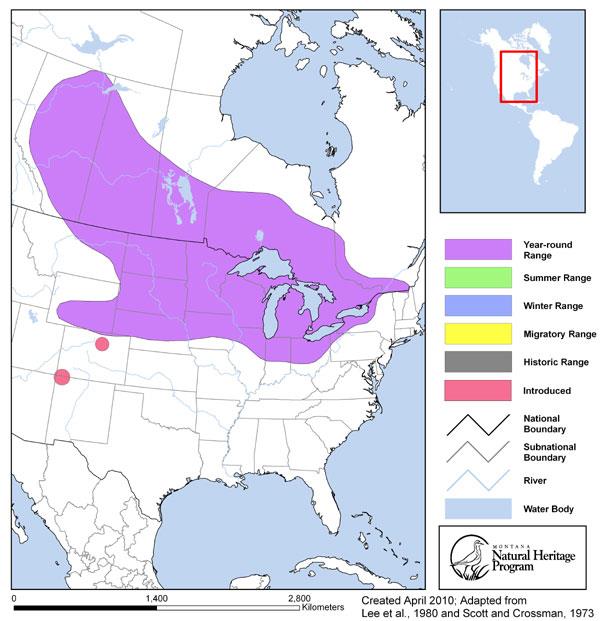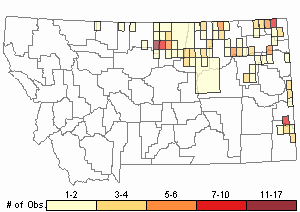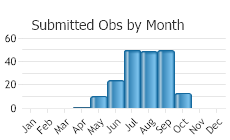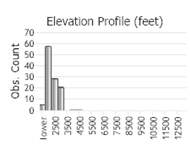View in other NatureServe Network Field Guides
NatureServe
Montana
Utah
Wyoming
Idaho
Wisconsin
British Columbia
South Carolina
Yukon
California
New York
Iowa Darter - Etheostoma exile
State Rank Reason (see State Rank above)
Species appears stable but is not widely distributed and threats are poorly characterized
General Description
There are about 100 species of small perches called darters. In Montana we have only one representative, the Iowa Darter. It is a native fish found in small streams and reservoirs in the plains region of our eastern drainage. During the spawning season, this species becomes one of Montana's most highly colored fish. Its maximum size is a little less than 3 inches (Brown 1971, Holton and Johnson 1996).
For a comprehensive review of the ecology, conservation status, threats, and management of this and other Montana fish species of concern, please see
Montana Chapter of the American Fisheries Society Species of Concern Status Reviews.Diagnostic Characteristics
Iowa Darters are greenish or brownish with about eight saddle bands across the back and about nine to twelve dark blotches on the side. Teardrop mark below the eye is diagnostic to darters. In breeding males these blotches become bluish-green with rust-red between them. The underside becomes orange and the first dorsal fin has a reddish band between a blue outer edge. The body is slender, the eye large, and the lateral line is incomplete (Brown 1971, Holton and Johnson 1996).
Species Range
Montana Range
Range Descriptions

 Native
Native
Western Hemisphere Range

Range Comments
Iowa Darters range across much of south-central Canada and the north-central United States, in the St. Lawrence-Great Lakes, Hudson Bay, and Mississippi River basins. In Montana, Iowa Darter range more widely within the northern glaciated regions than the southern Great Plains ecoregions.
Observations in Montana Natural Heritage Program Database
Number of Observations: 197
(Click on the following maps and charts to see full sized version)
Map Help and Descriptions
Relative Density

Recency



 (Observations spanning multiple months or years are excluded from time charts)
(Observations spanning multiple months or years are excluded from time charts)
Migration
Not studied in Montana. Elsewhere, longer movements tend to be localized and related to breeding. They are found near shores of lakes and streams during breeding and then they move to deeper water in lakes or stream pools. Movements may occur from lakes into streams, probably over distances of several hundred meters (several hundred yards). In Michigan, movements to breeding areas began during mid-March to early April. Males tended to initiate migration slightly before females (Winn 1958a, 1958b).
Habitat
Iowa Darters prefer clear slow-flowing streams with solid bottoms, although they have a wide range of tolerance for changes in water flow rates. They are also found in lakes and reservoirs, such as Nelson Reservoir east of Malta (Brown 1971) and in stock ponds of the Matador Ranch on Big Warm Creek (Stagliano 2012). In Little Beaver Creek (Carter County), Iowa Darters were present during April to August in upstream and midstream pools and riffles that were characterized by cooler, clearer, lower water-velocity habitats, but were absent from downstream segments that were sampled, which had more riffles, reduced stream flows, and elevated late-summer water temperatures (to 30 C or more) (Barfoot and White 1999). Temperatures were 12-15 C in breeding pools of streams in Colorado during late April to early June, and the fish were found in masses of organic debris and slime on the pool bottoms; during the remainder of the year they were found under pebbles and in riffles in higher velocity water (Jaffa 1917). Breeding habitat in Michigan typically included the slow current of streams that contained some vegetation and submerged fibrous root banks. In lakes, Iowa Darters bred near shores over areas of fibrous root and organic debris. Sandy bottoms were often present in breeding habitats, males were never seen in muddy areas. After breeding, Iowa Darters moved to deeper waters of stream pools or lakes; in winter they could be found in thick organic debris and plants, to depths of 1.2 m (4 ft) (Jaffa 1917, Winn 1958a, 1958b).
Food Habits
Not studied in Montana. Food consists mostly of small crustaceans and aquatic insect larvae (Brown 1971). An examination of 100 stomachs (August 1968 to September 1969) from Sand Creek, Albany County Wyoming listed fly larvae in 54% of the stomachs, mayfly nymphs in 42%, caddisfly larvae in 15%, amphipods in 31%, and beetle adults, leaches, ostracods, copepods, snails, rotifers, and fish eggs in 1-4% of the stomachs; 12 stomachs were empty (Copes 1976). Overall, aquatic insects made up 64.7%, amphipods 14.6%, and animal remains 14.1% of the total volume. Stomachs contained an average of 4.2 food items. Larval Iowa Darters move to the surface or mid-strata of the water column near channel margins, where they feed on cladocerans and copepods (Turner 1921).
Ecology
Not studied in Montana (see Habitat comments). Iowa Darters were found in the stomachs of three Creek Chubs and one Brown Trout, and predaceous diving beetles attacked Iowa Darters while they were in fish traps (Copes 1976). In Sand Creek, Albany County Wyoming, the number of individuals per 100 ft of stream (800 ft sampled) during September were Age Class 0 = 9.3 (22.4%), Age Class 1 = 30.1 (73.4%), Age Class 2 = 1.6 (3.9%); respective Age Class biomass (grams) per 100 ft of stream were 4.2, 48.7, and 3.7. Age Classes 3 and 4 were rare.
Reproductive Characteristics
Not studied in Montana. No parental care is given to the young. Fish become brightly colored when spawning (Brown 1971). In Michigan (Winn 1958a), the reproductive period is April and May, when males establish territories. Males establish territories and guard an area of 30-60 cm diameter at the margin of a stream or near a lake shore. Size of reproductive females (Age Class 2) was 41-43 mm standard length. Females deposit 3-7 eggs per spawning in organic debris and fibrous mud banks, an average of 1619 eggs total are laid per female. Class 1 females (34-37 mm standard length) laid 550-962 eggs, Class 2 females (41-43 mm) laid 1404-1798 eggs, Class 3 females (46-47 mm) laid 1912-2048 eggs. Water-hardened eggs are 0.9-1.1 mm in diameter, and possess a single pale yellow oil globule and an opaque yolk (Simon and Faber 1987). Incubation is for 9 to 26 days in laboratory aquaria (Jaffe 1917, Winn 1958a, Simon and Faber 1987). Eggs are abandoned by the adults during incubation.
Management
No management activities specific to Iowa Darter are currently occurring in Montana. Distributional structured surveys to assess population status and life history throughout the state, including focusing on some previously un-surveyed habitats (ponds) would be useful.
Stewardship Responsibility
Threats or Limiting Factors
As with many small native stream fishes, Iowa Darters could be adversely effected by stream channelization, reductions to discharge, changes in water quality, and introductions of non-native predatory fishes, especially northern pike.
References
- Literature Cited AboveLegend:
 View Online Publication
View Online Publication Brown, C.J.D. 1971. Fishes of Montana. Bozeman, MT: Big Sky Books/Montana State University. 207 p.
Brown, C.J.D. 1971. Fishes of Montana. Bozeman, MT: Big Sky Books/Montana State University. 207 p. Copes, F.A. 1976. The Iowa darter, Etheostoma exile. American Currents, November/December.
Copes, F.A. 1976. The Iowa darter, Etheostoma exile. American Currents, November/December. Holton, G. D. and H. E. Johnson. 1996. A field guide to Montana fishes. Second Edition. Montana Department of Fish, Wildlife and Parks, Helena. 104 pp.
Holton, G. D. and H. E. Johnson. 1996. A field guide to Montana fishes. Second Edition. Montana Department of Fish, Wildlife and Parks, Helena. 104 pp. Jaffa, B. B. 1917. Notes on the breeding and incubation periods of the Iowa, Darter, Etheostoma iowae Jordan and Meek. Copeia (47): 71-72.
Jaffa, B. B. 1917. Notes on the breeding and incubation periods of the Iowa, Darter, Etheostoma iowae Jordan and Meek. Copeia (47): 71-72. Lee, D.S., C.R. Gilbert, C.H. Hocutt, R.E. Jenkins, D. E. McAllister, J. R. Stauffer, Jr. 1980. Atlas of North American freshwater fishes. North Carolina State Musuem of Natural History. 867 p.
Lee, D.S., C.R. Gilbert, C.H. Hocutt, R.E. Jenkins, D. E. McAllister, J. R. Stauffer, Jr. 1980. Atlas of North American freshwater fishes. North Carolina State Musuem of Natural History. 867 p. Scott, W.B. and E.J. Crossman. 1973. Rainbow trout, Kamloops trout, Steelhead trout Salmo gairdneri Richardson. pp. 184-191. In: Freshwater fishes of Canada. Ottawa, Canada: Fisheries Research Board of Canada, Bulletin 184. 966 p.
Scott, W.B. and E.J. Crossman. 1973. Rainbow trout, Kamloops trout, Steelhead trout Salmo gairdneri Richardson. pp. 184-191. In: Freshwater fishes of Canada. Ottawa, Canada: Fisheries Research Board of Canada, Bulletin 184. 966 p. Simon, T.P. and D.J. Faber. 1987. Descriptions of eggs, larvae, and early juveniles of the Iowa darter, Etheostoma exile (Girard), from Lac Heney, Quebec. Canadian Journal of Zoology 65 (5): 1264-1269.
Simon, T.P. and D.J. Faber. 1987. Descriptions of eggs, larvae, and early juveniles of the Iowa darter, Etheostoma exile (Girard), from Lac Heney, Quebec. Canadian Journal of Zoology 65 (5): 1264-1269. Turner, C.L. 1921. Food of the common Ohio darters. Ohio Journal of Science 41-62.
Turner, C.L. 1921. Food of the common Ohio darters. Ohio Journal of Science 41-62. Winn, H. E. 1958. Comparative reproductive behavior and ecology of fourteen species of darters (Pisces-Percidae). Ecological Monographs 28(2): 155-191.
Winn, H. E. 1958. Comparative reproductive behavior and ecology of fourteen species of darters (Pisces-Percidae). Ecological Monographs 28(2): 155-191. Winn, H. E. 1958. Observation on the reproductive habits of darters (Pisces-Percidae). American Midland Naturalist 59 (1): 190.
Winn, H. E. 1958. Observation on the reproductive habits of darters (Pisces-Percidae). American Midland Naturalist 59 (1): 190.
- Additional ReferencesLegend:
 View Online Publication
View Online Publication
Do you know of a citation we're missing? Barfoot, C.A. 1993. Longitudinal distribution of fishes and habitat in Little Beaver Creek, Montana. M.Sc. Thesis. Bozeman, MT: Montana State University. 66 p.
Barfoot, C.A. 1993. Longitudinal distribution of fishes and habitat in Little Beaver Creek, Montana. M.Sc. Thesis. Bozeman, MT: Montana State University. 66 p. Barfoot, C.A. and R.G. White. 1999. Fish assemblages and habitat relationships in a small northern Great Plains stream. The Prairie Naturalist 31(2):87-107.
Barfoot, C.A. and R.G. White. 1999. Fish assemblages and habitat relationships in a small northern Great Plains stream. The Prairie Naturalist 31(2):87-107. Hendricks, P., S. Lenard, D.M. Stagliano, and B.A. Maxell. 2013. Baseline nongame wildlife surveys on the Fort Peck Indian Reservation. Report to the Assiniboine and Sioux Tribes of the Fort Peck Indian Reservation. Montana Natural Heritage Program, Helena, MT. 83 p.
Hendricks, P., S. Lenard, D.M. Stagliano, and B.A. Maxell. 2013. Baseline nongame wildlife surveys on the Fort Peck Indian Reservation. Report to the Assiniboine and Sioux Tribes of the Fort Peck Indian Reservation. Montana Natural Heritage Program, Helena, MT. 83 p. Joslin, Gayle, and Heidi B. Youmans. 1999. Effects of recreation on Rocky Mountain wildlife: a review for Montana. [Montana]: Montana Chapter of the Wildlife Society.
Joslin, Gayle, and Heidi B. Youmans. 1999. Effects of recreation on Rocky Mountain wildlife: a review for Montana. [Montana]: Montana Chapter of the Wildlife Society. Mullins, M.S. 1991. Biology and predator use of cisco (Coregonus artedi) in Fort Peck Reservoir, Montana. M.Sc. Thesis. Bozeman, MT: Montana State University. 68 p.
Mullins, M.S. 1991. Biology and predator use of cisco (Coregonus artedi) in Fort Peck Reservoir, Montana. M.Sc. Thesis. Bozeman, MT: Montana State University. 68 p. Stash, S.W. 2001. Distribution, relative abundance, and habitat associations of Milk River fishes related to irrigation diversion dams. M.Sc. Thesis. Bozeman, MT: Montana State University. 82 p.
Stash, S.W. 2001. Distribution, relative abundance, and habitat associations of Milk River fishes related to irrigation diversion dams. M.Sc. Thesis. Bozeman, MT: Montana State University. 82 p. Stringer, A.L. 2018. Status of Northern Pearl Dace and chrosomid dace in prairie streams of Montana. M.Sc. Thesis. Bozeman, MT: Montana State University. 150 p.
Stringer, A.L. 2018. Status of Northern Pearl Dace and chrosomid dace in prairie streams of Montana. M.Sc. Thesis. Bozeman, MT: Montana State University. 150 p. USDI Bureau of Land Management. No date. Fishes of the Miles city, Montana BLM District. Miles City, MT: Miles City BLM District pamphlet. 12 p.
USDI Bureau of Land Management. No date. Fishes of the Miles city, Montana BLM District. Miles City, MT: Miles City BLM District pamphlet. 12 p. Wuellner, M.R. 2007. Influence of reach and watershed characteristics on fish distributions in small streams of eastern Montana. M.Sc. Thesis. Bozeman, MT: Montana State University. 80 p.
Wuellner, M.R. 2007. Influence of reach and watershed characteristics on fish distributions in small streams of eastern Montana. M.Sc. Thesis. Bozeman, MT: Montana State University. 80 p.
- Web Search Engines for Articles on "Iowa Darter"
- Additional Sources of Information Related to "Fish"





